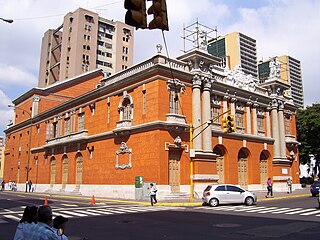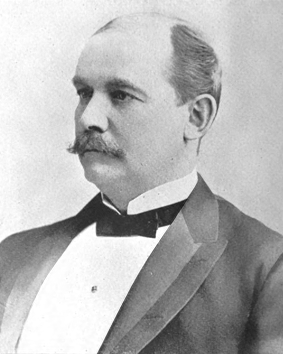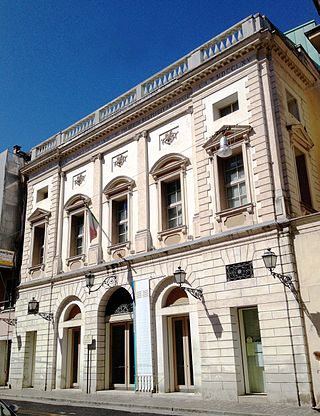This article needs additional citations for verification .(January 2017) |

The Teatro Municipal of Caracas is an opera house in Venezuela. It was inaugurated by President Guzmán Blanco in 1881. The theatre was initially named after the president.
This article needs additional citations for verification .(January 2017) |

The Teatro Municipal of Caracas is an opera house in Venezuela. It was inaugurated by President Guzmán Blanco in 1881. The theatre was initially named after the president.

The building was designed by Esteban Ricard, a French architect who left Venezuela before the project was completed. It was finished under the direction of the Venezuelan engineer Jesús Muñoz Tébar. The building incorporates structural ironwork imported from Great Britain, as there was no domestic production at the time. [1]
In 1896, President Joaquín Crespo commemorated General José Tadeo Monagas by erecting a statute of him in front of the theatre in a move for political unity. [2]
The building was modified in 1949 to facilitate redevelopment of central Caracas.

It is one of the oldest opera houses in South America; it opened on January 4, 1881, with Italian composer Errico Petrella's 1858 opera Jone , which was revived for the centennial of the theatre in 1981 with noted Argentine soprano Adelaida Negri in the title role. [3] by It continues to mount operatic productions. [4] but it is no longer the city's main opera house since the Teresa Carreño Cultural Complex opened in the 1980s. The Teatro Municipal is the home of the Municipal Symphony Orchestra of Caracas .

The Teatro Regio is a prominent opera house and opera company in Turin, Piedmont, Italy. Its season runs from October to June with the presentation of eight or nine operas given from five to twelve performances of each.

María Teresa Gertrudis de Jesús Carreño García was a Venezuelan pianist, soprano, composer, and conductor. Over the course of her 54-year concert career, she became an internationally renowned virtuoso pianist and was often referred to as the "Valkyrie of the Piano". Carreño was an early adopter of the works of one of her students, American composer and pianist Edward MacDowell (1860–1908) and premiered several of his compositions across the globe. She also frequently performed the works of Norwegian composer and pianist Edvard Grieg (1843–1907). Carreño composed approximately 75 works for solo piano, voice and piano, choir and orchestra, and instrumental ensemble. Several composers dedicated their compositions to Carreño, including Amy Beach and Edward MacDowell.
Errico Petrella was an Italian opera composer.

The Teatro dell'Opera di Roma is an opera house in Rome, Italy. Originally opened in November 1880 as the 2,212 seat Costanzi Theatre, it has undergone several changes of name as well modifications and improvements. The present house seats 1,600.

The Teatro Real is an opera house in Madrid, Spain. Located at the Plaza de Oriente, opposite the Royal Palace, and known colloquially as El Real, it is considered the top institution of the performing and musical arts in the country and one of the most prestigious opera houses in Europe.
Rubén Domínguez was a Venezuelan lirico-spinto tenor. He is recognized for his work within the lirico-spinto repertory, as well as works by Bellini and Donizetti. He played many verismo roles such as Canio in Pagliacci. He also played Otello, Mario Cavaradossi, Manrico, Radamés and Calaf.
Francisco Kraus Trujillo was a Spanish baritone.

In Venezuela, since the opening of the Teatro Caracas and, earlier, the Teatro Maderero, there has been a great lyrical tradition ranging from serious opera to operetta, zarzuela, and Spanish musical reviews.

The Teatro Nacional de Venezuela is a building and associated theatre company in Caracas. The theatre presents plays, operas and zarzuelas.
The following is a timeline of the history of the city of Caracas, Venezuela.
Carlo Negrini was an Italian spinto tenor and creator of Gabriele Adorno in Verdi’s opera Simon Boccanegra.

Giovanni Guicciardi was an Italian opera singer who sang leading baritone roles in the opera houses of Italy and Portugal. He is most remembered today for having created the role of Count di Luna in Verdi's Il trovatore. He created also several other leading roles in operas by lesser known Italian composers. Guicciardi accumulated a considerable fortune during the course of his career. After his retirement from the stage, he taught without payment in music schools in his native city, Reggio Emilia, and presided over a charity for orphaned musicians. He died in San Polo d'Enza at the age of 64.

The Teatro Capranica is a theatre situated at 101 Piazza Capranica in the Colonna district of Rome. Originally constructed in 1679 by the Capranica family and housed in the early Renaissance Palazzo Capranica, it was the second public theatre to open in Rome. It was the site of many premieres of Baroque operas including Caldara's Tito e Berenice, Scarlatti's Griselda, and Vivaldi's Ercole su'l Termodonte. The Capranica ceased operating as a full-scale theatre and opera house in 1881 and in 1922 was converted into a cinema. Following the closure of the cinema in 2000, it has functioned on a hire basis as a conference and performance venue.

Abbey, Schoeffel and Grau was a US theatre management and production firm, active from 1880 until 1896. The partners were Henry E. Abbey, John B. Schoeffel and Maurice Grau. Abbey and Schoeffel had been in partnership since 1876, and joined forces with Grau in 1882. They managed and ran a number of theatres in New York and Boston, including the Metropolitan Opera House in 1883-4 and from 1891 to 1896, when Abbey died. Schoeffel and Grau remained at the Met until 1903.

Francis Romero (Caracas) is a Venezuelan actress of theatre, film, radio, and television.

The Teatro Simón Bolívar is a cultural and theatre complex located in the Libertador Municipality of Caracas. It is in the Rialto building near the Yellow House, the La Francia building, and Plaza Bolívar.
Venezuela had been introduced to cinema in the 1890s. After an initial boom in screenings and production, the presence of cinema in the nation was lower between 1900 and 1910.

The Teatro Mario Del Monaco is an opera house and theatre in Treviso, Italy. It was previously known as the Teatro Onigo from 1692 to 1846, the Teatro Sociale from 1847 to 1930, and the Teatro Comunale from 1931 to 2011. In 2011, it was renamed in honour of the Italian tenor Mario Del Monaco who lived in Treviso from 1975 until his death in 1982. It is located in the historic centre of the city on the Corso del Popolo and since 2019 has been run by the Teatro Stabile del Veneto which also runs the Teatro Goldoni in Venice and the Teatro Verdi in Padua.